L) 48. Rb1!
 Position L), after 48. Rf1-b1. Starting point for White's ending win.
Position L), after 48. Rf1-b1. Starting point for White's ending win.
Now 48...Kf4 49. Bd2+/-, 48...Kd5/d4 49. Ba3+/-, 48...Bf6/h8
49. Ba3 Nc4 50. Bxb2+/-, and 48...Bd4 49. Bc5!+/- are quickies.
We consider: 1) 48...Kd3, 2) 48...Kf3, 3) 48...Be5+, 4) 48...Ng4+,
5) 48...Nd5, and most of all, 6) 48...Nc4 and 7) 48...Kf5.
L1) 48...Kd3 49. Ba3! and:
L11) 49...Nc4 50. Bxb2 Nxb2 51. Rxb2 Bxb2 52. h6+/-.
L12) 49...Kc2 50. Bxb2 Bxb2 51. Rxb2+ Kxb2 52. g7 Ng4+ 53. Kg3 Nh6
54. Kf4+/-.
L2) 48...Kf3 49. Ba3 Ng4+ (49...Nc4 50. Bxb2+/-) 50. Kh1 (perhaps even
better 50. Kh3) and now:
L21) 50...Nf6 51. Bxb2 and:
L211) 51...Nxh5 52. Bxg7 Nxg7 53. Rb7+/-.
L212) 51...Bxb2 52. Rxb2 Nxh5 53. Rb7+/-.
L22) 50...Nf2+ 51. Kg1 Nh3+ (51...Bd4 52. Bxb2+/-) 52. Kf1 Nf4
53. Bxb2 e5 (else +/= as in L21) 54. Re1 Nd3/Nxh5 55. Bxe5!+/-
(e.g. 55...Bh6 56. Ba1 and 57. Re7---Black's King is too far up).
L3) 48...Be5+ 49. Kh3 and:
L31) 49...Kf5 50. Bd2! (50. Bf8?! Kf6! 51. g7 Kf7 looks OK for Black).
This is a major difference from the hypothetical note to 50. Rh1!
in the main file (58Rd1.html#50Rh1), where Black's Knight is
already on c4. Things seem to wind up quickly after:
L311) 50...Nc4 51. Rf1+ Ke4 52. h6 Nxd2 53. Re1+ +/- (or
alternatively 52. Bh6 Na3 53. g7 Bxg7 54. Bxg7+/-).
L312) 50...Nd5 51. Rf1+ Ke4 52. h6+/-.
L313) 50...Ng4 51. Rf1+ +/- similarly.
L32) 49...Bg7 (or B-any) 50. Ba3 Nc4 51. Bxb2+/-.
L33) 49...Nc4 50. h6+/-.
L34) 49...Nf5 50. Bd2+/- or 50. Ba3+/-.
L35) 49...Kd3 50. Ba3 Kc2 51. Rxb2!+ +/-.
L4) 48...Ng4+ 49. Kg3 Nf6 50. Kh4 Nd5 51. Ba3+/-.
L5) 48...Nd5 49. Ba3 and now:
L51) 49...Nf4 50. Bxb2 e5 (50...Bxb2 51. Rxb2 Nxh5 52. Rb7+/-)
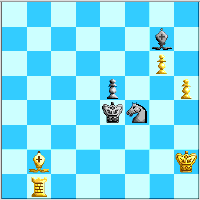
51. Kg3! Nxh5+ 52. Kg4 Nf6+ 53. Kg5+/-. White's 51. Kg3! is
a key resource, and the +/- evaluation is because Black
cannot keep White's King from invading via f5.
L52) 49...Be5+ 50. Kh3 Nf4+ 51. Kg4 Nd3 52. h6+/- or 52. Bxb2+/-.
It is probable that 49. Bd2 wins here as well.
L6) 48...Nc4 49. Kg3! Instead, 49. Kh3?! Kf5 leaves White seeking
transposition after 50. Kh4 Bf6+ 51. Kg3 Bg7 52. Rh1!, and gives
Black extra chances such as 51...Be5+!? or 51...Bh8! (52. Rh1 Bg7!
brings about the "mutual-Zug" with White to move). Now:
L61) 49...Kf5 50. Rh1! brings about the Zug with Black to move,
and this is continued as Position M). Black's other tries
with the 48...Nc4 move order seem not to last long, starting
with one of the marquee tactical points:
L62) 49...Kd3 50. Ba3!! and now:
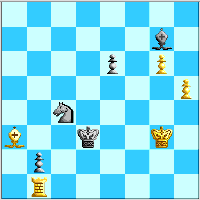
L621) 50...Nxa3 51. Rxb2! with:
L6211) 51...Bxb2 52. h6+/-, as Black's Knight is too far away.
L6212) 51...Ke4 52. Rb7 Be5+ 53. Kg4 Nc4 54. g7 Ne3+ 55. Kg5+/-
L6213) 51...Nc4 52. Rb7 Ne3 53. Rxg7 Nf5+ 54. Kh3 Nxg7 55. h6+/-,
or 52...Be5+ 53. Kh3 Nd1 54. g7+/-.
L622) 50...Kc2 and now:
L6221) 51. Rxb2+? Nxb2 52. Bxb2 Kxb2 53. Kf4 e5+! 54. Kg5 e4
55. Kf4 Kc3 56. Kxe4 Kc4! 57. Kf5 Kd5 58. Kg5 Ke6=.
L6222) 51. Bxb2! and now:
L62221) 51...Bxb2 52. Rxb2+ +/-.
L62222) 51...Nxb2 52. Rf1! Nc4 53. Rf7 Bh6 54. g7 Bxg7
55. Rxg7 Nd6 56. Kf4+/-.
L62223) 51...Kxb1 52. Bxg7+/-.
L62224) 51...e5 52. Rc1+ Kd3 53. Rxc4 Kxc4 54. Kg4 +/-.
L63) 49...Ke3 50. Ba3! with the same business as in L62).
L64) 49...Kd5 50. Ba3! (or simply 50. Kf3).
L65) 49...Bh6 50. Bc3 Bc1 51. Bxb2+/-, or 51. g7+/-.
L66) 49...e5 50. Bc3 Kd3 51. Bxb2 Kc2 52. Rc1+ +/-.
L67) 49...Nb6/e3 50. Ba3+/-.
L68) 49...Be5+ 50. Kh4 (also good is 50. Kg4) and:
L681) 50...Kf5 51. Rf1+ Ke4 52. h6+/-.
L682) 50...Bf6+ 51. Kh3, and now:
L6821) 51...Kf5 52. Rf1+ Kg5 (else 53. h6+/-) 53. Be7! is a
stinger that comes up often.
L6822) 51...Bg7 52. Bc3!! Bxc3 53. h6+/-. This is one of the
ultimate reasons Black loses the whole line! See M8211).
L7) 48...Kf5 49. Kg3! White was not ready for 49. Bd2 Nc4 50. Rf1+ Kg4,
when 51. Bc3 Bxc3 52. h6 Ne3! 53. Rg1+ Kh5! 54. g7 Ng4+ 55. Rxg4
b1=Q 56. g8=Q Be5+ is equal, and 51. h6 Nxd2 52. Rg1+ Kh5!
53. hxg7 Nf3+ 54. Kg2/h1 Nxg1 55. g8=Q b1=Q 56. Qh7+ Kg5 is likewise
equal with the g-pawn pinned. Moreover, 49. Kh3 Nc4! transposes
into the corresponding note to L6), and 49. Kg2 Nc4 50. K-any Kg5
or 50. Rh1 Kg5 51. Be7+ Kh6! achieves even less. Now, however:
L71) 49...Nc4 50. Rh1! is the dreadful Zugzwang position M).
Black has more tries to evade it than in line L6), however.
We dispatch 2) 49...Kg5, 3) 49...e5, 4) 49...Ke4, 5) 49...Ng4,
and 6) 49...Nc2 quickly enough, but need to dwell on 7) 49...Nd5
and 8) 49...Be5+ for some time.
L72) 49...Kg5 50. Bd2+/-.
L73) 49...e5 50. Rxb2 Nd5 51. Rf2+! (Black's trick was 51. Bd2 Nf4!
with apparent sudden equality) Kg5 52. Rf7 Nxb4 53. Rxg7 Kxh5
54. Rb7+/-.
L74) 49...Ke4 50. Ba3 Nc4 51. Bxb2+/-.
L75) 49...Ng4 50. Rf1+ Kg5 51. Bd2+ Kxh5 52. Rh1+ Kxg6 53. Kxg4+/-.
L76) 49...Nc2 50. Bd2 and now:
L761) 50...Na3 51. Rf1+ Ke4/e5 52. h6+/-, with BN offside.
L762) 50...Nd4 51. Rf1+! Ke4/e5 52. h6 Nc1+ 53. Rxc1+/-.
L763) 50...Be5+ 51. Kh3 with:
L7631) 51...Na3 52. h6+/-.
L7632) 51...Kf6 52. Rf1+ Kg7 53. Rf7+ Kg8 54. h6!+/-.
L77) 49...Nd5 50. Bd2! (50. Ba3? Nf4! holds) and now:
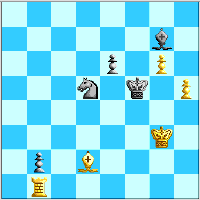
L771) 50...Nc3 51. Rf1+! Ke4 52. Bxc3 Bxc3 53. h6 Bd2 54. g7 Bc1
55. g8=Q+/- owing to the skewer, or perhaps more simply
52. h6 Ne2+ 53. Kg4 Nc1 54. Rxc1 bxc1=Q 55. Bxc1+/-.
L772) 50...e5 51. h6+/-, actually a pity for Black, as 51. Rf1+?
and 51. Rxb2? both run into the apparently equalizing 51...Nf4!
L773) 50...Ke4 51. h6 Be5+ 52. Kg4 Ne7 (52...Nf6+ 53. Kg5+/-)
53. g7 Kd3 54. Bg5+/-.
L774) 50...Nf6 51. Kh4 Ne4 52. Rf1+ Ke5 53. Bf4+ Kd5/d4 54. h6+/-.
L775) 50...Bd4/f6/h8/f8 51. Rf1+ Ke4 52. h6+/-.
Black's one hopeful try seems to be:
L776) 50...Be5+ 51. Kf3. For an aside, 51. Kh3 may be even better, with
51...Nf6 52. Kh4, when 52...Ne4 53. Rf1+ is comical, and with
51...Bf6 52. Rf1+ Ke4 53. h6 Kd3 54. g7 Bxg7 55. hxg7 Nf6
56. Bg5! Ng8 57. Kg4!+/- as another main line. However, the
present line arises also by transposition from 49...Be5+ 50. Kf3 Nd5
51. Bd2 below, in L782). Now:
L7761) 51...Nc3 52. Rxb2 and Black has no ammo.
L7762) 51...Bg7 52. h6+/-.
L7763) 51...Bh8 (intending 52...e5) is Black's best try here:
L77631) 52. Rf1!? e5!, and since 53. Kg3+ Nf4! 54. Bxf4 exf4+
55. Rxf4+ Kg5 56. Rb4/f1 Kxh5 is drawn, things look
suddenly unclear.
L77632) 52. Bh6!?
L77633) 52. Ke2! and now:
L776331) 52...Nc3+ doesn't quite work: 53. Bxc3 Bxc3
54. Kd3 Bg7 55. Rg1! and now:
L7763311) 55...Bf6 56. Kc2 Bg7 57. h6+/-. The only try to
head off this threat seems to be:
L7763312) 55...e5 56. Kc2 e4 57. h6 Bxh6 58. g7 Bxg7
59. Rxg7 Kf4 60. Kxb2 e3 61. Kc3 Kf3 62. Kd2+/-.
Overall, Black can trade N for B only when BK can reach g5.
L776332) 52...Nf4+ 53. Bxf4 Kxf4 54. Rxb2! +/-.
L776333) 52...e5 53. Rxb2 Nf4+ 54. Bxf4 exf4 55. Rb8+/-, or
53...Kg4 54 . h6+/-.
L776334) 52...Nf6 53. Rf1+ Ke4/g4 54. h6+/-.
L776335) 52...Ne7 53. Rg1! and:
L7763351) 53...Ke4 54. Rg4+ Kd5 55. Rb4+/-, as White is
too active, or 54...Kf5 55. Rf4+! +/-.
L7763352) 53...e5 54. Kd3 e4+ 55. Kc2 Bf6 56. g7 Ng8
57. h6+/-.
L776336) 52...Ke4 53. h6+/-.
L7764) 51...Nf6 52. g7! Ng8 53. h6 Kg6.
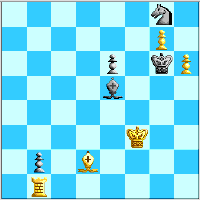
Black's defensive shell is not trivial to break, and we speculate
that if Black could say "pass" with the material after losing the
e-pawn, this would be drawn! However, White can break this down
by using Zugzwang after winning the e-pawn. The most typical
line is: 54. Ke4 Bf6 55. Kd3 Ne7 (55...e5 56. Kc2 does not
help) 56. Re1! (56. Kc2 Bd4! is less clear), and now:
L77641) 56...Kf7 57. Kc2 and now:
L776411) 57...N-any or B-any 58. Rh1 any 59. h7 wins a piece.
L776412) 57...Kg6 58. Rxe6 Kf7 (58...Ng8 59. Bc3+/-)
59. Rb6 Bd4/Nd5 60. Rb7(+) Bf6/Ne7 61. Bc3+/-.
L77642) 56...Kh7 57. Kc2 Ng8 58. Rxe6 and this is the final Zugzwang.
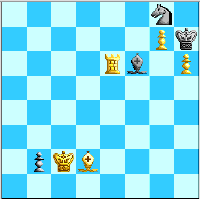
Black cannot play 58...Kg6 owing to 59. Bc3,
so 58...Bd4 allowing 59. Bg5! is forced, and 59...Bc3
60. Rb6 Bd4 61. Rxb2! is the end. If Black could play
58...pass 59. Rb6 pass, however, 60. Rxb2 Bxb2 61. Kxb2
fails to 61...Ne7, and White is unable to stop ...Nf5xg7.
L7765) 51...Kf6 52. Ke3 Bc3, and now not:
L77651) 53. Kd3? Bxd2 54. Kxd2 Nf4 and wins the h-pawn to equalize, but
L77652) 53. Bh6! Ne7 (almost forced) 54. Rf1+ Nf5 55. Kd3 Bd4
56. Kc2 Be5 (what else?) 57. Bd2 Kg7 58. Re1! Bf6 59. Re4+/-
as Black cannot play 59...Ng3 and faces 60. Rb4-b7+.
L78) 49...Be5+ and now:
L781) 50. Kh3!? Kf6!? After 51...Nf5 Black will have a decent defensive
organization, and while we suspect White is still winning, this
looks less clear than other lines. But White has:
L782) 50. Kf3! and now:
L7821) 50...Nd5 51. Bd2 transposes to L776).
L7822) 50...Nc2 51. Bf8!, another "cryin' shame" for Black:
L78221) 51...Kf6 52. Ke4+/- as Black is ruined.
L78222) 51...Nd4+ 52. Kg2 Kf6 53. Rxb2+/-.
L7823) 50...Ng4 51. Bd2 and now:
L78231) 51...Nf6 52. g7 transposes into L7764).
L78232) 51...Bh8 52. Ke2! and now:
L782321) 52...Nf6 53. Rf1+ Ke4/g4 54. h6+/- is L776334).
L782322) 52...Bg7 53. Kd3 and:
L7823221) 53...e5 54. Rf1+ Ke6 55. Kc2 e4 56. Rf4+/-.
L7823222) 53...Ne5+ 54. Kc2 Nc4/g4 55. Rf1+ Ke4 56. Rf4+ and
takes the Knight next move, +/-.
L782323) 52...Ke4 53. h6+/-.
L782324) 52...Ne5 53. Rxb2+/-.
L7824) 50...Nc4 and now:
L78241) 51. Rh1 transposes into line M3) below.
L78242) 51. Ke2 seems to win more directly along lines of
L776) and L78).
I see no other ideas for Black to try to avoid the Zugzwang position M),
considered now:
M): 48. Rb1! Kf5/Nc4 49. Kg3! Nc4/Kf5 50. Rh1!
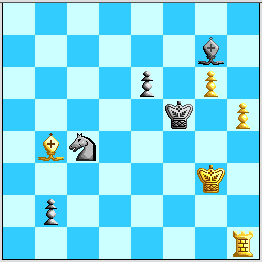 Position M), after 50. Rh1 in main line. Zugzwang! (mutual!)
Position M), after 50. Rh1 in main line. Zugzwang! (mutual!)
To illustrate the subtlety of this Zugzwang, Black has no fewer than nine
reasonable replies, not counting things like 50...Ne5 51. Bc3+/-:
1) 50...Ne3, 2) 50...Bd4, 3) 50...Be5+, 4) 50...Bf6, 5) 50...Bh8,
6) 50...Nb6, 7) 50...Bh6, 8) 50...Ke4, and 9) 50...e5. Make that ten
with 50...Kf6 51. Bc3+ e5, but 50...e5 51. Bc3 Kf6 is considered below. !!
The common theme of the first six is that Black loses a tempo by
needing to set his Bishop or Knight back on their restraining
squares g7 or c4 before going after White's h-pawn, and White's
King scoots to the Q-side fast enough to hit Black's Knight on c4 and
catch Black's pawn before Black can profitably sacrifice it.
Line 7) gets skewered, line 8) loses a B+P vs. N ending, and
line 9) gives Black the choice of going out with a bang, a
publishable R+2P vs. N+2P study, or a long whimper.
M1) 50...Ne3 51. Bd2 and:
M11) 51...Nc4 52. Rf1+ Ke4 53. Bg5 Na3 54. h6+/-.
M12) 51...Nd5 52. Rf1+ Ke4 53. h6+/-.
M2) 50...Bd4 51. Kf3 (not 51. Bf8 Nd2) and now we consider:
1) 51...e5, 2) 51...Ne5+, 3) 51...Kg5, and 4) 51...Bg7.
M21) 51...e5 52. Ke2 e4 53. Bf8! Ke6 54. h6 Kf7 55. h7 Bxg7 56. Rf1+ +/-.
M22) 51...Ne5+ 52. Ke2 and:
M221) 52...Kg5 53. g7+/-.
M222) 52...Nc6 53. Bf8 Kf6 54. Rf1+ +/-.
M223) 52...Ng4 53. Bd2! and Black is stymied as in similar cases of L):
M2231) 53...Bg7 54. Rf1+ Ke4 55. Rf4+ Kd5 56. Rb4+/-.
M2232) 53...Nf6 54. Rf1+ Ke4/g4 55. h6+/-.
M2233) 53...e5 54. Rf1+ Ke4/e6 55. h6+/-.
M2234) 53...Ne5 54. g7+/-.
M2235) 53...Ke4 54. h6+/-.
M23) 51...Kg5 52. Ke4 and now 1) 52...Bg7, 2) 52...Bf6, and 3) 52...Bh8:
M231) 52...Bg7 53. Kd3. An important juncture:
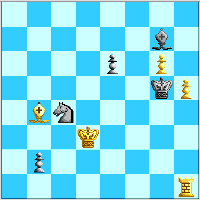
M2311) 53...Nb6 54. Bd2+ Kf5/g4 55. h6+/-.
M2312) 53...Ne5+ 54. Kc2 and:
M23121) 54...Ng4/c6 55. Bd2+ Kf5 56. h6+/-, as WK covers b1.
M23122) 54...Nc4 and now not
M231221) 55. Bc3? b1=Q+! 56. Rxb1 Na3+ 57. Kb2/c1/d3 Nxb1
58. Bxg7 Kxh5=, but preparation with
M231222) 55. Rh3! +/- as Black cannot stop 56. Bc3.
M23123) 54...Nf3 55. Be7+ Kh6 56. Ba3+/-.
M23124) 54...Bf6/h8 55. Bc3+/-.
M2313) 53...b1=Q+ Rxb1 and now:
M23131) 54...Nb2+ 55. Kc2 Kxh5 56. Bc3+/-, as Black's Knight
will be trapped.
M23132) 54...Ne5+ 55. Ke4 and the tactics go wrong for Black:
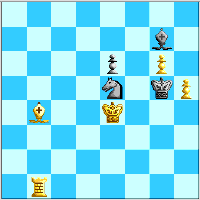
M231321) 55...Kxh5 56. Bc3 and:
M2313211) 56...Nc4 57. Rh1+ Kxg6 58. Rg1+ +/-.
M2313212) 56...Nf3 57. Rh1+ Kxg6 58. Bxg7 Ng5+ 59. Kf4+/-
(if only Black had no e-pawn here!)
M231322) 55...Ng4 56. Bd2+! Kxh5 57. Rb5+ e5 58. Kf5+/-.
White's 56. Bd2+! is an especially critical blow, as
otherwise Black might escape into the g6 vs. e6 ending
featured in the hypothetical play in position M
if White were on move. Until MacChess sees the
strength of 58. Kf5, the principal variations
that it shows from Move 50 head down this way!
M231323) 55...Nd7 56. Be7+! Kxh5 57. Rb7+/-.
M231324) 55...Nc6 56. Bd6! Kxh5 57. Rb6 (or 57. Rd1) and now:
M2313241) 57...Nd4 58. Be5 Bxe5 (58...Nf5 59. Rxe6)
59. Kxe5 Nf5 60. Kf6+/-.
M2313242) 57...Na7 (57...Nd8 58. Be7+/-; 57...Na5 58. Rb5+ +/-)
58. Bb8 Nc8 59. Rxe6+/- (58. Be5 wins too).
M232) 52...Bf6 53. Kd3! (not 53. Be7? b1=Q! 54. Rxb1 Kxh5=), and now:
M2321) 53...Nb6 54. Bf8+/-.
M2322) 53...Ne5+ 54. Ke2 and now:
M23221) 54...Nc4 55. Be7!+/-.
M23222) 54...Ng4 55. Bd2+ Kf5 56. Rf1+ +/-.
M23223) 54...Nc6/d7 55. Bd2+ Kf5 56. Rf1+ Ke4/g4 57. h6+/-.
M23224) 54...Nf3 55. Be7!+/-.
M233) 52...Bh8 53. Kd3 (53. Be7+ Kh6 54. Bf8+ Kg5 is less clear) and:
M2331) 53...Nb6 54. Bf8+/-.
M2332) 53...Ne5+ 54. Kc2 and now:
M23321) 54...Nc4 55. Be7+ (many moves win, but this one kills), and:
M233211) 55...Kh6 56. Bf8+ Bg7 57. Bxg7+ Kxg7 58. h6+ Kxg6
59. h7+/-.
M233212) 55...Kg4 56. h6+/-.
M233213) 55...Kf5 56. Rf1+ Ke4 57. Bf6+/-, or 56...Ke5 57. h6+/-.
M23322) 54...Nc6/d7 55. Bd2+ Kf5 56. Rf1+ Ke4/g4 57. h6+/-.
M23323) 54...Nf3 55. Bc3 e5 56. Bxb2+/-.
M23324) 54...Ng4 55. Bd2+ Kf5 56. Rf1+ +/-.
The basic idea here is that once WK gets to the Q-side, Black
can't contain the liberated White Rook and Bishop.
This finishes M23) 51...Kg5. The next block is more of the same.
M24) 51...Bg7 52. Ke2 and:
M241) 52...e5 53. Kd3 Nb6 54. Kc2 and now:
M2411) 54...Nd5 55. Bd2 B-any 56. Rf1+ +/-.
M2412) 54...Kg5 55. Bd2+/-.
M2413) 54...e4 55. h6+/-.
M2414) 54...Nc4 55. h6+/-.
M2415) 54...Kg4 55. h6+/-.
M2416) 54...Bf6 55. Kxb2+/-.
M242) 52...Kg5 53. Kd3 transposes into M231).
M243) 52...Kg4 53. Kd3+/-. Black is just lost when WK reaches c2.
M25) 51...Be3 52. g7 Bc1 53. g8=Q+/- owing to the skewer.
M3) 50...Be5+ 51. Kf3 and:
M31) 51...Kg5 52. Ke4 and:
M311) 52...b1=Q+ 53. Rxb1 Kxh5 54. Rc1 Nb2 55. Kxe5 Nd3+
56. Kf6 Nxc1 57. g7+/-.
M312) 52...Bg7/h8 ==> M231), M233).
M313) 52...Kh6 53. Kd3 Nd6 54. Bd2+ Kg7 55. Bc3+/-.
M32) 51...Nb6 52. Bf8+/-.
M4) 50...Bf6 51. Rf1+! and:
M41) 51...Kg5 52. Be7+/-.
M42) 51..Ke4 52. h6+/-.
M5) 50...Bh8 51. Kf3 and Black's problems recur in slightly different forms:
M51) 51...e5 52. Ke2 and now:
M511) 52...e4 53. Bf8+/-.
M512) 52...Kg5 53. Kd3 Nb6 54. Kc2 Nd5 55. Bf8+/- or Bd2+/-.
M513) 52...Nb6 53. Kd3 Nd5 54. Bd2 Nf4+ 55. Kc2 and now:
M5131) 55...Kg4 56. Bxf4 exf4 57. h6+/-.
M5132) 55...Kg5 56. Kxb2+/- as nothing is threatened.
M5133) 55...e4 56. Bxf4+ Kxf4 57. h6+/-.
M52) 51...Kg5 52. Ke4 and now:
M521) 52...B-moves transpose into previous lines.
M522) 52...b1=Q 53. Rxb1 Kxh5 54. Rh1+ +/-. A major pity!
Now the Zugzwang picture with Black's Bishop is complete:
50...Bh8 allows this skewer, 50...Bf6 allows Be7! shots, and
50...Bd4 and 50...Be5 allow untimely hits on the Bishop by Ke4.
If only Black could play 50...Bg7!
M523) 52...Ne5 53. Bc3+/-.
M524) 52...Nb6 53. Bd2+ Kg4/f5 54. h6/Kd3+/-.
M53) 51...B-moves 52. Ke2 transposes into previous lines.
M6) 50...Nb6 51. Bd2 and now:
M61) 51...Nc4 52. Rf1+ Ke4 and White need merely be patient:
M611) 53. h6? Nxd2 54. Re1+ Kf5 55. hxg7 Ne4+ 56. Kf3 Nf6=.
M612) 53. Bg5! This is another of Black's basic problems:
M6121) 53...Ne3 54. Bxe3 Kxe3 55. Rb1! any 56. Rxb2+/-.
M6122) 53...Na3 54. h6 Be5+ 55. Kg4 b1=Q 56. Rxb1 Nxb1 57. g7+/-.
M6123) 53...Nd6 54. Kg4! Nf5 55. Rd1!
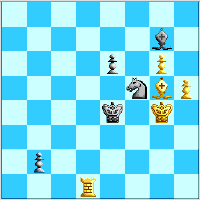
White's last may not be needed to win, but it is a neat bit of
sadism, as the ugly
M61231) 55...Ke5 is basically forced. Then 56. Rb1 Ke4 57. h6!
is a new basic winning mechanism, with:
M612311) 57...Bxh6 58. Bxh6 Nxh6+ 59. Kg5 Nf5/g8 60. Rxb2+/-.
M612312) 57...Nxh6 58. Bxh6 Bxh6 59. Rxb2, and finally:
M6123121) 59...Ke5 60. Rf2! any 61. Rf7+/-.
M6123122) 59...e5 60. Rf2 Kd5 61. Kf5!+/-.
M61232) 55...Ne3/h6+ 56. Bxe3/h6 and 57. Rb1+/-.
M62) 51...Nd5 52. Rf1+ Ke4 53. h6+/-.
M63) 51...Be5+ 52. Kh3! and:
M631) 52...Nc4 53. Rf1+ Ke4 54. h6 Nxd2 55. Re1+ +/-.
M632) 52...Nd5 53. Rf1+ Ke4 54. h6+/-.
M64) 51...Nd7 52. Rf1+ Ke4 53. h6+/-.
M7) 50...Bh6 51. Bc3 and now:
M71) 51...Bc1 52. Rf1+! and now:
M711) 52...Ke4 53. Bxb2 Bxb2 54. Rf7 (54. h6 also wins) Nd6
55. g7 Bxg7 56. Rxg7 Nf5+ 57. Kg2 Nxg7 58. h6+/-. This is a
common motif: Black's Knight can't stop the pawn.
M712) 52...Kg5/g4 53. g7 b1=Q 54. g8=Q+ and mate in a few.
M72) 51...Kg5 52. g7 Bxg7 53. Bxg7 and:
M721) 53...Kxh5 54. Bc3+/-.
M722) 53...e5 54. h6 Kg6 55. Rb1+/-.
M73) 51...e5 52. Kf3! transposes into N) 50...e5 51. Bc3 Bh6 52. Kf3.
There is nothing else worth looking at here, as White's Bishop getting
to c3 is a killer unless Black does something.
M8) 50...Ke4; now White appears to have two winning moves:
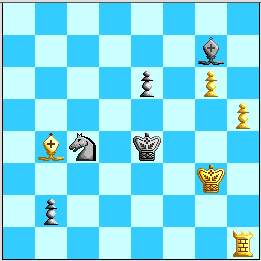 Position after 50...Ke4. 51. Rd1 Kf5! would only repeat, but...
Position after 50...Ke4. 51. Rd1 Kf5! would only repeat, but...
M81) 51. Kg4!? and now:
M811) 51...Ne5+ 52. Kh3 (other squares repeat) and now:
M8111) 52...Nd3 53. Bd2 leads to:
M81111) 53...Nc1 54. Rxc1 bxc1=Q 55. Bxc1 Kf5 56. Be3! This is
a slow but sure win, as Black's King must stick near f5.
White has time to swing his King in one big circle to f7
via the b-file and e8!
M81112) 53...Kf5 54. Rf1+ is decisive, as in similar lines above.
M8112) 52...Nf3 53. Kg3 is hopeless for Black.
M8113) 52...Nc4 53. Bc3!! is line M8211) below.
M812) 51...Bh6 52. Bc3 Bc1 53. Bxb2 Bxb2 54. h6 Ne3+ 55. Kg5 Nf5
56. Rf1+/-, as Black cannot stop 57. Rxf5.
M813) 51...Ne3+ 52. Kg5 Nf5 53. Rd1! is even worse for Black than
line M6123).
M814) 51...Kd3 52. Kg5! is the same as the main line M823) below.
Since the main lines are the same, and M81111) is a long haul, the
following is probably the more accurate choice for White:
M82) 51. Kh4!, and now 1) 51...Bf6+, 2) 51...Bh6, 3) 51...Kd3,
4) 51...Ne3, or 5) 51...Ne5:
M821) 51...Bf6+ 52. Kh3!, and now:
M8211) 52...Bg7 53. Bc3!! is the most fundamental reason that
Black loses, showing that Black is unable to maintain the
positional balance established at move 47. Now comes:
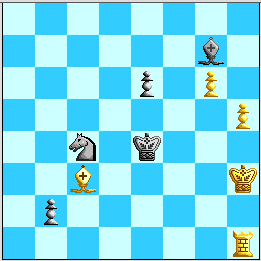 Position after 53. Bc3!! White's main sacrificial strike.
Position after 53. Bc3!! White's main sacrificial strike.
M82111) 53...Bxc3 54. g6 (+/-) Bd2 55. g7 Bc1 56. g8=Q +/-,
the good old skewer again!
M82112) 53...e5 54. Rf1! and now:
M821121) 54...Bh6 55. Bxb2 Nxb2 56. Rf7+/-.
M821122) 54...b1=Q 55. Rxb1 Kf5 56. Rb7+/-.
M8212) 53...Ne5 53. Bc3+/-.
M8213) 52...Kf5 53. Rf1+ and:
M82131) 53...Kg5 54. Be7!+/-, that old killer tactic.
M82132) 53...Ke4/e5 54. h6+/-.
M8214) 52...Bg5 53. g7 Bc1 54. g8=Q+/-.
As nothing else prevents 53. h6, 52. Kh3! leaves Black cooked.
M822) 51...Bh6 52. Bc3 and now:
M8221) 52...Bc1 gives White two choices:
M82211) 53. g7!? b1=Q 54. g8=Q. At last a case where Black
queens first. Has Black escaped the skewer? Black
is down material, and there seems nothing to do except
for the one check: 54...Bg5+, but 55. Kxg5! Qxh1
56. Qa8+ skewers Black on the other diagonal!
M82212) 53. Bxb2(!) Bxb2 54. h6 Nd6 (54...Ne3 55. Re1+/-)
55. Rf1! Ne8 56. Rf8+/-.
M8222) 52...Kd3 53. g7 Bxg7 54. Bxg7 Kc2 55. Bxb2+/-.
M8223) 52...e5, and now White has several approaches.
M82231) 53. Bxb2(!) Nxb2 54. Rg1! and now:
M822311) 54...Bg7 55. Kg5 Nc4/d3 56. h6+/-.
M822312) 54...Kf5 55. g7 Bxg7 56. Rxg7 e4 57. h6 e3 58. Re7+/-.
M822313) 54...Nc4 55. g7 Bxg7 56. Rxg7 Nd6 57. Kg5 Nf5
58. Rg6+/-. Black will not even get to sac the
Knight for the h-pawn.
M82232) 53. Rb1 Kd3 54. Bxb2 Kc2 55. Rc1+! and now:
M822321) 55...Kxb2/Kb3/Kd3 56. Rxc4+/-.
M822322) 55...Bxc1 56. Bxc1 Nd6 57. g7 Nf5+ 58. Kg4! Nxg7
59. h6 Ne8 60. Kg5 Nd6 61. Kg6+/-.
M82233) 53. Rd1 also wins.
Computer programs may reject 51. Kh4, however, because they cannot
see to the end of the following lines.
M823) 51...Kd3 52. Kg5! and now:
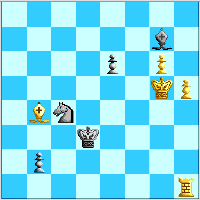
M8231) 52...Kc2 53. h6 and now:
M82311) 53...Bxh6+ 54. Kxh6 Ne3 55. Kg5! Nf5 (55...Nd1 56. Rh2+ +/-)
56. Kf6 b1=Q 57. Rxb1 Kxb1 58. Kxe6 is EGTB+/- #16.
M82312) 53...Bd4 54. Rh2+ Kb3 55. Rxb2+ +/-.
M8232) 52...Bd4, and now White has:
M82321) 53. h6!? Be3+ 54. Kh5 Bc1 55. g7 b1=Q 56. g8=Q Qxb4. This
is probably winning for White, but much clearer is the
following refinement:
M82322) 53. Bc5! Bc3 (53...Bxc5 54. g7+/-) 54. h6 Bd2+ 55. Kh5 Bc1
56. g7 b1=Q 57. g8=Q Qb5 (what else?) 58. Rxc1 Qxc5+
59. Qg5, and this is +/-.
M824) 51...Ne3 52. Kg5 Nf5 53. Rd1! is M813)
M825) 51...Ne5 52. Rb1! (52. Kg5 Nf3+ 53. Kg4 Ne5+ is M811) and now:
M8251) 52...Nc4 53. Kg5+/-.
M8252) 52...Nd3 53. Kg5 (53. Ba3 and 53. Bd2 win too) Nxb4
54. h6 Bxh6+ 55. Kxh6 Nd5 56. Rxb2+/-.
M8253) 52...Nf3+ 53. Kg3 (semi-Zugzwang) Be5+ 54. Kg4 Bg7 55. Ba3+/-.
M8254) 52...Kf5 53. Rf1+ Ke4 54. Ba3! and now:
M82541) 54...Nc4 55. Bxb2! Bxb2 (55...Nxb2 56. Kg5+/-) 56. h6 Nd6
57. g7+/-, as White's Rook on f1 covers f5.
M82542) 54...Nf3+ 55. Kh3! and now:
M825421) 55...Ke3/f4 56. Bxb2 Bxb2 57. Rxf3+ +/-.
M825422) 55...Nd2 56. Bxb2!+/-.
M82543) 54...Bf6+ 55. Kh3 Nc4 56. Bxb2! Bxb2 57. h6+/-.
This finishes the win against 50...Ke4.
M9) 50...e5 51. Bc3. Not only is this the natural reaction, it seems
to be the only winning one as anything else permits 51...e4 keeping
White's King from entering the Queenside. Now again Black has
several reasonable tries: 1) 51...Bh6, 2) 51...Ke6, 3) 51...Bf6,
4) 51...Bh8, and the main line 5) 51...Kg5.
M91) 51...Bh6 52. Kf3 (52. Rb1? Kg5) and now:

M911) 52...Bc1 53. Bxb2 Bxb2 54. g7+/-.
M912) 52...Kf6 53. Ke2 and now:
M9121) 53...Bc1 54. Bxb2 Bxb2 55. Rf1+ Kg7 (else 56. g7+/-)
56. Rf7+ and now:
M91211) 56...Kh6 57. Kh4 any 58. Rh7 mate.
M91212) 56...Kg8 57. h6 Ba3 (57...e4 58. Rf8+ +/-) 58. Ra7 Bf8
59. h7+ Kh8 60. Ra8+/-.
M91213) 56...Kh8 57. g7+ Kh7 58. Rf8+/-.
M9122) 53...Kg7 54. Kd3 Bc1 55. Bxb2 Nxb2+ 56. Kc2+/-.
M913) 52...e4+ 53. Ke2 and now:
M9131) 53...Bc1 54. Rf1+! is another typical misfortune for
Black, as White will queen with check and soon mate.

M9132) 53...Ke6 54. g7 Kf7 55. Rf1+ +/-.
M914) 52...Ke6 53. Ke2, and now:
M9141) 53...Bc1 54. Bxb2 Bxb2 55. g7 Kf7 56. h6 Kg8 57. Rg1+/-,
or 56...e4 57. Rf1+ +/-.
M9142) 53...Kd5/f5 54. Kd3 e4+ 55. Kc2+/-.
M915) 52...Kg5 53. Ke4 Bg7 54. Kd3 transposes into M9221) below.
M92) 51...Ke6 and now:
M921) 52. Rb1?! Kf5! 53. Bxb2 Kg5 looks strangely OK for Black.
M922) 52. Kf2! White is not dissuaded from his plan. Now:
M9221) 52...Bh6 53. Ke2 transposes into M914).
M9222) 52...Kf5 53. Ke2 and now Black is powerless to stop 54. Kd3.
The last question is whether Black can hit back or endure
when White plays it. The next line is White's crucial coup.
M92221) 53...Kg5 54. Kd3 and now:
M922211) 54...Na3 and now:
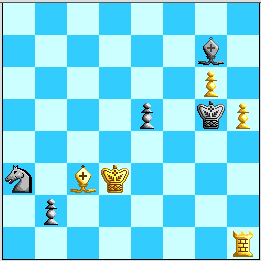 Position after 54...Na3 in main "waiting" line. Are White's pawns corraled?
Position after 54...Na3 in main "waiting" line. Are White's pawns corraled?
M9222111) 55. Bxb2? e4+ 56. Kxe4 Bxb2 seems to hold for Black:
57. Rg1+ Kh6! (not 57...Kxh5? 58. g7 Bxg7 59. Rxg7
EGTB+/- #23 as Black cannot save the Knight)
58. Kf5, and now both 58...Nb5 and 58...Nc4 look OK.
M9222112) 55. h6!! and now:
M92221121) 55...Bxh6 56. Bxb2 and:
M922211211) 56...Bf8 57. g7+/-.
M922211212) 56...e4+ 57. Kxe4 Nc4 58. g7 Bxg7 59. Bxg7+/-.
M922211213) 56...Nb5 57. Bc1+ +/-.
M92221122) 55...e4+ 56. Kxe4 Bxc3 57. g7+/-.
M92221123) 55...b1=Q+ 56. Rxb1 and now:
M922211231) 56...Kxh6 57. Rb3 e4+ 58. Kxe4 and:
M9222112311) 58...Bxc3 59. Rxc3 EGTB+/- #13
M9222112312) 58...Nc4/c2 59. Bxg7+ Kxg7 60. Rb4/b2
EGTB+/- #13/#11
M922211232) 56...Bxh6 57. Rb3+/-.
M922211233) 56...e4+ 57. Kxe4 Nxb1 (57...Bxc3 58. hxg7+/-)
58. hxg7 Nxc3+ 59. Ke5+/-.
Black certainly went out with a bang in these lines.
M922212) 54...Nd6 55. Bxb2 is just resignation.
M922213) 54...b1=Q+ 55. Rxb1 Na3 56. Rb3+/-.
M92222) 53...Kg4 54. Kd3 Na3 55. h6+/-; note also 55. Bxb2 e4+
56. Kxe4 Bxb2 57. Rg1+ Kxh5 58. g7 Bxg7 59. Rxg7 EGTB+/- #23
M9223) 53...Kf6 54. Kd3+/- as Black's e-pawn is pinned.
M9224) 53...Ke6 54. Kd3 and now:
M92241) 54...Na3 and now White must switch his choices:
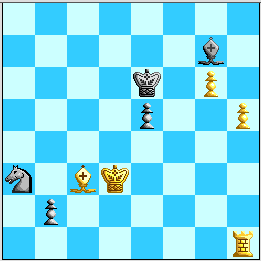 Position after 54...Na3 in alternate "waiting" line. Play it again Sam?
Position after 54...Na3 in alternate "waiting" line. Play it again Sam?
M922411) 55. h6? and now:
M9224111) 55...Bxh6 56. Bxb2 Bf8 57. g7+/-.
M9224112) 55...b1=Q+ 56. Rxb1 Bxh6 (56...Nxb1 57. hxg7 is
still +/-) 57. Rb3 e4+ 58. Kxe4 Nc4 59. g7 Nd6+
60. Kd3! Kf7 61. Rf1+ +/-.
M9224113) 55...e4+! and we see a clear difference from line
M9221): on 56. Kxe4 Bxc3 57. g7 Black can cover g8
by 57...Bxg7 58. hxg7 Kf7 and draws. But White has:
M922412) 55. Bxb2! e4+ 56. Kxe4 Bxb2 57. h6 and now:
M9224121) 57...Kf6 58. g7 Kf7 59. Rf1+ +/-.
M9224122) 57...Nc4/b5 58. g7 Nd6+ 59. Kd3 (simplest; 59. Kf4
may be quicker) Bxg7 (59...Kf7 60. Rf1+ +/-)
60. hxg7 EGTB+/- #14 owing to 60...Kf7 61. Rg1 Kg8
62. Kd4 Nf5+ 63. Ke5 Nxg7 64. Kf6.
M92242) 54...Kd5 55. Kc2 Ne3+ (only way to stop 56. h6)
56. Kxb2 Nf5/g4 57. Kc2 Ke6/e4 58. Bd2+/-.
M9225) 53...Ke4 54. Bxb2! Nxb2 55. h6+/-.
M93) 51...Bf6 52. Kf2! and now:
M931) 52...Ke4 53. Bxb2! Nxb2 54. h6 Nd3+ 55. Kf1+/-, as Black's
Knight can't get back in time.
M932) 52...e4 53. g7! Bxg7 54. Bxg7+/-.
M933) 52...Kg5 53. Ke2 and now:
M9331) 53...Bg7 54. Kd3 transposes into M9221).
M9332) 53...b1=Q 54. Rxb1 Kxh5 55. Rg1. Most lines with this exchange
of pawns are covered below under "N)", but this represents one
opportunity for Black to get the King off the h-file by 55...Kh6.
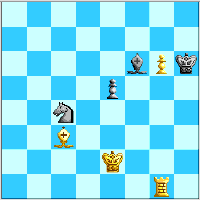
However, White cuts Black off by 56. Bb4! Kg7 (White threatens
57. Bf8+, and 56...Bg7 57. Kd3 Nb6/b2+ 58. Ke4 wins as in N23)
57. Kd3 and now:
M93321) 57...Nb6 58. Ke4 Nc4 59. Kf5 Ne3+ 60. Ke6+/-. Once the
White King gets to f5, the twin threats of Bf8+ and Rh2
cannot be stopped.
M93322) 57...Nb5+ 58. Ke4+/- similarly.
M9333) 53...e4 54. g7+/- as in M932).
M9334) 53...Bh8 and now:
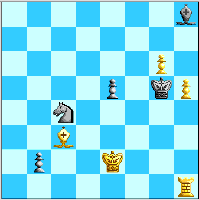
M93341) 54. Kd3? Na3! and now:
M933411) 55. Bxb2 e4+ 56. Kxe4 Bxb2 is M9222111), which Black
seems to hold after 57. Rg1+ Kh6! 58. Kf5 Nb5 or Nc4.
M933412) 55. Bd2+ Kf5 56. Rf1+ Ke6 57. h6 b1=Q 58. Rxb1 Nxb1
59. g7 Bxg7 60. hxg7 Kf7 61. Bh6 Na3=.
M93342) 54. Bb4! and now:
M933421) 54...e4 55. Bf8+/-.
M933422) 54...Bg7 55. Kd3 Nb6 56. Bd2+ Kf5 57. Rf1+ Ke4/g4
58. h6+/-.
M933423) 54...Kh6 and White has two thematic ways to win:
M9334231) 55. Bf8+ Bg7 56. Bxg7+ Kxg7 57. Rb1 is one
tempo down for Black compared to the main line in N11),
from 51...Kg5 52. Kf2 Kh6 53. Ke2 e4 54. Bxg7+ Kxg7
55. Rb1 e4 56. Ke1! As that is a Zugzwang line, we
cover the tempo-down version separately here.
Since 57...Kh6 58. Kd3 is +/-, Black has only 57...e4,
when White advances with 58. Kd1 and now:
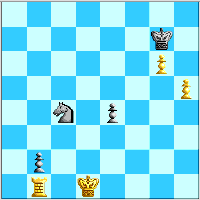
M93342311) 58...Kh6 59. Kc2 and now:
M933423111) 59...Na3+ 60. Kxb2 Nxb1 61. Kxb1+/- as White's
King is in the square of Black's e-pawn.
M933423112) 59...e3 60. Kd3 transposes into N11334243),
which is the main line of the analysis under N11).
M933423113) 59...Nd6/e5 60. Rxb2+/- as Black still cannot
play 60...Kxh5.
M93342312) 58...Ne3+ 59. Kd2 Nf5/g4 60. Rxb2 Kh6 61. Rb7+/-.
M93342313) 58...e3 59. Ke2 Kh6 60. Kd3+/- again as in N11334243).
Easier, however, may be
M9334232) 55. Kd3 Nb6 56. Bd2+ Kg7 57. Rg1! Kf6 (else 58. h6+/-)
58. Rf1+ Kg7 (58...Ke6 59. h6+/-) 59. Rf7+ Kg8
60. Kc2 e4/Nc4 61. h6 Bd4 62. h7+ +/-.
M9335) 53...Kh6 and now:
M93351) 54. Kd3? Na3! seems to work again.
M93352) 54. Bb4! and now:
M933521) 54...e4 55. Bf8+ Bg7 56. Bxg7 Kxg7 57. Rb1! transposes
into N113) below. This may be the main line...
M933522) 54...Bg7 55. Kd3+/- (mate on d2 coming!).
M933523) 54...Kg5 55. Bf8+/-.
M933524) 54...b1=Q 55. Rxb1 Kxh5 56. Rg1 and now:
M9335241) 56...Kh6 57. Bf8+ Bg7 58. Rh1+! Kxg6 59. Rg1+ +/-.
M9335242) 56...Bg7 57. Kd3 Nb6/b2+ 58. Ke4 is already
adjudgable as +/-.
M933525) 54...Bh8 55. Kd3+/-.
M933526) 54...Kg7 55. Kd3 Nb6 56. Ba3! and now:
M9335261) 56...Na4 57. Kc2 e4 58. Kb3+/-.
M9335262) 56...Nd5 57. Bxb2 e4+ 58. Kxe4! +/-.
M934) 52...Bg7 53. Ke2 transposes into M9222).
M94) 51...Bh8 52. Kf2! and now:
M941) 52...Ke4 53. h6+/-.
M942) 52...Kg5 53. Ke2 and now:
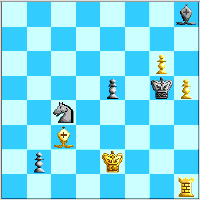
M9421) 53...Bg7 54. Kd3 is M9221).
M9422) 53...b1=Q 54. Rxb1 Kxh5 55. Rh1+ +/-.
M9423) 53...Bf6 and now:
M94231) 54. Kd3? Na3! seems to hold as in M93341).
M94232) 54. Bb4! and now:
M942321) 54...e4 55. Bf8+/-.
M942322) 54...Bg7 55. Kd3 transposes into M933422).
M942323) 54...Kh6 55. Bf8+ Bg7 56. Bxg7+ transposes into
M933423); White also has 55. Kd3 here.
M9424) 53...Kh6 and now:
M94241) 54. Kd3? Na3! seems to work again.
M94242) 54. Bb4! and now:
M942421) 54...e4 55. Bf8+ Bg7 56. Bxg7 Kxg7 57. Rb1! transposes
into N113) below. This may be the main line...
M942422) 54...Bg7 55. Kd3+/- (mate on d2 coming!).
M942423) 54...Kg5 55. Bf8+/-.
M942424) 54...b1=Q 55. Rxb1 Kxh5 56. Rh1+ +/-.
M942425) 54...Bh8 55. Kd3+/-.
M942426) 54...Kg7 55. Kd3 Nb6 56. Bc3+/-.
M943) 52...Bg7 53. Ke2 transposes into M9222).
M95) 51...Kg5, and now:
M951) 52. Kf3? involves:
M9511) 52...e4+? 53. Kxe4 Bxc3 54. Kd3 b1=Q+ 55. Rxb1 Na3 56. Rb3+/-,
or 55...Nd2 56. Rb5+ +/-.
M9512) 52...Na3! and now:
M95121) 53. Bxb2 e4+ 54. Kxe4 Bxb2 seems to hold for Black.
M95122) 53. h6 b1=Q! 54. Rxb1 Kxh6 55. Rg1 e4+ =, or 55. Rb3 Nc4=.
M952) 52. Kf2! leads to position N).
N) Position after 48. Rb1! Kf5/Nc4 49. Kg3! Nc4/Kf5 50. Rh1! e5 51. Bc3 Kg5
52. Kf2!
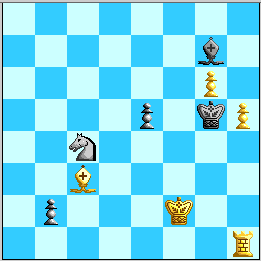 Position after 52. Kf2! in main line. Black is so close but too late.
Position after 52. Kf2! in main line. Black is so close but too late.
The lines in M9) above show that Black cannot hope to sit and hold.
The only two active strategies seem to be N1) 52...Kh6 53. Ke2 e4 and
N2) 52...b1=Q 53. Rxb1 Kxh5. The first leads to a neat endgame study,
while the second leads to a long twilight snuffing of Black's resistance.
N1) 52...Kh6 53. Ke2, and now:
N11) 53...e4 54. Bxg7+ Kxg7. It is important to note that 54. Bd2+!? Nxd2
55. Kxd2 Kg5! seems to leave White a tempo short, in particular after
56. Ke3 Kf5! 57. Rf1+! Ke5 58. Kd2 Kd4! 59. Kc2 e3 60. Kxb2 e2
61. Rh1 Kd3+ 62. Kb3 Bh6!! 63. Kb4 Kd2 64. Kc5 e1=Q 65. Rxe1 Kxe1
66. Kd6 Kf2 67. Ke6 Kg3 68. Kf7 Kh4=.
Now let us consider several White tries from the position after 54...Kxg7.
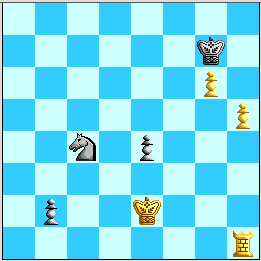 Position after 54...Kxg7 in first main line. A publishable study.
Position after 54...Kxg7 in first main line. A publishable study.
N111) 55. Rg1!? and now:
N1111) 55...Nd6/e5? 56. h6+ Kxh6 57. g7 b1=Q 58. g8=N+! Kh7/h5
59. Nf6+ Kh6/h4 60. Rxb1+/-. A cute underpromotion theme.
N1112) 55...Na3! 56. h6+ Kxh6 57. g7 b1=Q 58. Rxb1 Kxg7 EGTB=.
N112) 55. Rf1!? and now:
N1121) 55...Na3? 56. Rf7+ and now:
N11211) 56...Kh6 57. Rh7+ Kg5 58. g7+/-.
N11212) 56...Kh8 57. h6+/-.
N11213) 56...Kg8 57. h6 b1=Q 58. h7+ Kh8 59. Rf8+ Kg7 60. h8=Q+ +/-.
N1122) 55...Kh6 56. Rg1! and now:
N11221) 56...Nd6/e5 57. g7 b1=Q 58. g8=N+ Kxh5 59. Nf6+ Kh6/h4
60. Rxb1+/-.
N11222) 56...Na3 57. g7 b1=Q 58. Rxb1 Kxg7 59. Rb4 and now:
N112221) 59...Kh6 60. Rxe4 EGTB+/- #17.
N112222) 59...e3 60. Re4 Nb5 61. Kxe3 EGTB+/- #16.
N1123) 55...Ne5 56. Rb1! and now:
N11231) 56...Nc4 transposes into M9334231), the "tempo down"
version of the ending after 55. Rb1! below.
N11232) 56...Nd3 57. Ke3 Kh6 58. Kxe4+/-.
N11233) 56...Kh6 57. Rxb2 Nd3 58. Rb5! Nf4+ 59. Ke3 Nxh5
60. Rxh5+ +/-.
N1124) 55...Nd6! and now:
N11241) 56. Rb1 Kh6 57. Rxb2 Nf5! 58. Rb6 Ng3+ 59. Ke3 Nxh5
60. Kxe4 Kg5! EGTB=.
This is a key motif in this entire R+2P vs. N+2P ending---e2
is the one bad square for White's King.
N11242) 56. Ke3 Kh6 57. Kf4 Ne8! and now:
N112421) 58. Kxe4 Kxh5! 59. g7 b1=Q+ 60. Rxb1 Nxg7 EGTB=.
Tantalizingly, if White's King were on f4, 61. Rb6! would
be EGTB+/- #28.
N112422) 58. Rg1 Ng7=
N112423) 58. Rb1 Kxh5=.
N113) 55. Rb1! Kh6 (essentially forced).
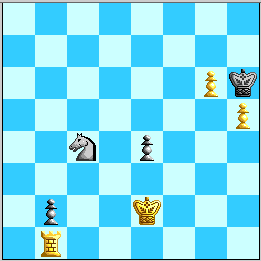 Position after 55...Kh6 in main line. Which King move wins?.
Position after 55...Kh6 in main line. Which King move wins?.
This too is a publishable study, focusing more than the diagram one move back
on the main nimble-stepping theme. White's intent is Kc2 and Rxb2 with White's
King in the square of Black's e-pawn. If Black responds to this threat by
pushing ...e3, then White hits the Knight by Kd3. To draw, however,
"all" Black has to do is win White's h-pawn in exchange for the b- and
e-pawns, setting up a drawn "Lasker vs. Lasker" position. The original
Lasker-Lasker position would be with White's Rook on b6 defending g6 and
Black's Knight on g7 and King on g5. Alternatively White's Rook can be
defending from g1, and both forms can occur one rank further up the board.
Exactly one of these four variants wins for White, and the object of the
study is to know and reach it. Black's basic defense shows in the first line.
N1131) 56. Kd1? Ne3+ and now:
N11311) 57. Kd2 Nf5! and now:
N113111) 58. Rxb2 Kxh5=, in fact EGTB= without Black's e-pawn,
the original Lasker-Lasker draw.
N113112) 58. Rh1 b1=Q 59. Rxb1 Kxh5= ditto.
N11312) 57. Ke1 Nf5! 58. Rxb2 Kxh5 59. Rg2 Kh6!, and this too is
EGTB= even without the e-pawn.
N1132) 56. Kf2? Kg7 57. Ke1 Kh6. Now White is in Zugzwang---58. Kd1
has already been covered, and the only non-repeating alternative
is to put White's King on the bad square: 58. Ke2 Nd6! and now:
N11321) 59. Rxb2 Nf5! and now:
N113211) 60. Rb6 Kxh5=.
N113212) 60. Rb7 Ng3+ (not 60...Kxh5? 61. g7) 61. Ke3 Nxh5 is
EGTB= even without the e-pawn.
N113213) 60. Rb5 Nd4+ =. Thus the key elements are Black's access
to g3 and d4 and White's King in the way of 60. Rh2!
N113214) 60. Kf2/d2/e1/d1/f1 Kxh5=.
N11322) 59. Ke3 Kxh5= as 60. Rxb2 is impossible.
N11323) 60. Ke1 Kxh5 61. Rxb2 Nf5! =.
N11324) 60. Rh1 Nf5 61. any b1=Q 62. Rxb1 Kxh5=.
Line N1132), however, serves the hint to the key to the study.
N1133) 56. Ke1!! and now we consider 1) 56...Kg7, 2) 56...Ne5,
3) 56...Nd6, and for the main line, 4) 56...e3.
N11331) 56...Kg7 57. Kd1, and now:
N113311) 57...Kh6 58. Kc2, and now:
N1133111) 58...Na3+ 59. Kxb2 Nxb1 60. Kxb1+/-.
N1133112) 58...Ne3+ 59. Kxb2 Nf5 60. Rh1 e3 61. Kc2+/-.
N1133113) 58...e3 59. Kc3 (also 59. Kd3 transposes to N1134243), and:
N11331131) 59...Nd2/d6 60. Rxb2 Kxh5 61. g7 Ne4+ 62. Kd3 Nf6
63. Rb8+/-.
N11331132) 59...Nb6 60. Kxb2 Nd5 61. Kc2 Kxh5 (61...Nf6
62. Rb5+/-) 62. g7 Nf6/e7 63. Rb8+/-.
N11331133) 59...Ne5/other 60. Rxb2+/-.
N1133114) 58...Nd6 59. Rxb2 Nf5 60. Rb7 Kxh5 61. g7 Nh6 62. Rb8+/-.
This illustrates why Black needs White's King to be on e2
in order for the Nd6-f5 idea to work, allowing 60...Ng3+.
N113312) 57...Ne3+ 58. Kd2 and now:
N1133121) 58...Nf5 59. Rxb2 Kh6 60. Rb7+/- ditto.
N1133122) 58...Ng4/d5 59. Rxb2 Kh6/Nf6 60. Rb5+/-.
N113313) 57...e3 58. Ke2! transposes into N11334) below.
N11332) 56...Ne5 57. Kd2 and now:
N113321) 57...Nc4+ 58. Kc3+/-.
N113322) 57...Nd3 58. Ke3 Ne5 59. Kxe4+/-.
N113323) 57...Nf3+ 58. Ke3! (58. Ke2? Nh4!=; 58. Kc2? e3!=) and now:
N1133231) 58...Nh2 59. Rxb2 Ng4+ 60. Kxe4 Kxh5 61. g7 and:
N11332311) 61...Kh6 62. g8=N! +/-.
N11332312) 61...Nf6+ 62. Kf5+/-.
N11332313) 61...Nh6 62. Rb8+/-.
N1133232) 58...Nh4 59. Kxe4 (easiest) +/-.
N1133233) 58...Ng5 59. Rxb2+/-.
N113324) 57...e3+ 58. Kxe3 (also 58. Ke2 wins) Kxh5 59. g7 Ng4+
60. Kf4 Nh6 61. Rxb2 Kg6 62. Rb7! EGTB+/- #24.
 Position after 62. Rb7 in main-line/transpositions. Black's ultimate end.
Position after 62. Rb7 in main-line/transpositions. Black's ultimate end.
This is our first encounter with White's main winning theme,
the one "Lasker-Lasker" case that fails to hold. The reason
is that White's King can approach f8 via the back rank, and
Black does not have the tempi to counterattack that Black has
with the g-pawn one square back. The main-line continuation is:
62...Kf6 63. Ke4 Ng8 64. Kd5 Nh6 65. Kc6! Ke6/g6 66. Rd7 Kf6
67. Kb7! (fastest) Kg6 68. Kc7 (a mini-Zugzwang) Kh7 (68...Kf6
69. Kd8 leaves Black no longer able to access h7) 69. Kd6! Kg6
70. Ke6 Ng8 71. Rf7 Kh7 (71...Nh6 72. Ke7!) 72. Kf5! Nh6+
73. Kf6 Ng8/g4+ 74. Kg5! Nh6 75. Rb7 Ng8 76. Ra7! Nh6 77. g8=Q+!
and this discovery finally wins the Knight.
N113325) 57...Ng4 58. Rxb2 and now:
N1133251) 58...Nf6 59. Rb5+/-.
N1133252) 58...Kxh5 59. g7 Nf6/h6 60. Rb8+/-.
N113326) 57...Nc6 58. Rxb2 Kxh5 59. g7 Ne7 60. Rb8+/-.
N113327) 57...Nd7 58. Rxb2 Kxh5 59. g7 Nf6 60. Rb8+/-.
N113328) 57...Kg7 58. Rxb2+/-.
N11333) 56...Nd6 57. Rxb2 Nf5 58. Rb5+/-.
N11334) 56...e3 and first let's review Black's main drawing idea:
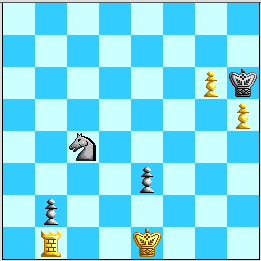 Position after 56...e3. Again, which King move wins?
Position after 56...e3. Again, which King move wins?
N113341) 57. Ke2? Nd6! and now:
N1133411) 58. Rxb2 Nf5! This differs from N11321) only in Black's
e-pawn being on e3 not e4, and the same Black magic works:
N11334111) 59. Rb7 Ng3+ 60. Kxe3 Nxh5 EGTB=,
with 61. Rb6 Kg5!
N11334112) 59. Rb5 Nd4+ =.
N11334113) 59. Rb6 Kxh5 = (EGTB= without Black's e-pawn).
N11334114) 59. Kf3 Kxh5 60. Kf4 Ng7! 61. Rb6/g2 e2!=
This last line shows that Black's e-pawn is needed.
N1133412) 58. Kxe3 Kxh5 59. g7 Nf5+ 60. Kf4 Nxg7 EGTB=,
but note that without Black's b-pawn White
would have 61. Rb6 EGTB+/- #28.
N1133413) 58. Kf3 and now:
N11334131) 58...Nc4 seems to leave White nothing better than
repeating.
N11334132) 58...e2 59. Kxe2 Nf5 60. Rxb2 Kxh5 EGTB=.
N1133414) 58. Rh1 Nf5 59. Kf3 e2!=.
N113342) 57. Kd1! and now:
N1133421) 57...Nd6 58. Rxb2 and now:
N11334211) 58...Ne4 59. Rh2+/-.
N11334212) 58...Nf5 59. Rh2 e2+ 60. Ke1 Ng3 61. Rh3+/-.
N1133422) 57...Ne5 58. Rxb2 and now:
N11334221) 58...Nd3 and now:
N113342211) 59. Rb7? e2+! 60. Kxe2 Nf4+ 61. Kf3 Nxh5 EGTB=.
N113342212) 59. Rh2 Nf4 and now:
N1133422121) 60. Rh4? e2+! =
N1133422122) 60. Rh1! Kg7 61. h6+! +/-, or
60...e2+ 61. Ke1+/-.
N113342213) 59. Rb5! Nf4 60. Ra5! makes most clear that Black
has no hope.
N11334222) 58...Ng4/N-else 59. Rb5! wins similarly.
N1133423) 57...Nb6 58. Rxb2 Nd5 59. Ke1! (easiest) Nf4 60. Rb5+/-,
with Rf5 coming.
N1133424) 57...Kg7 58. Ke2, and now we see the point of White's Zugzwang:
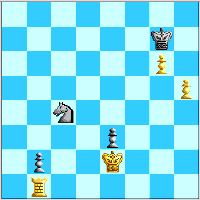
N11334241) 58...Nd6 59. Rxb2 Nf5 60. Rb7+ +/-.
N11334242) 58...N-other 59. Rxb2+/-.
N11334243) 58...Kh6 59. Kd3 and now:
N113342431) 59...Ne5+ 60. Kxe3 (not 60. Ke4 Nc4 61. Kd4? Nc2!-/+)
Kxh5 61. g7 Ng4+ 62. Kf4 Nh6 63. Rxb2 Kg6 64. Rb7!
EGTB+/- #24.

This line, seen above in N113324), is the main reason
White wins here.
N113342432) 59...Nd6 60. Rxb2 Nf5 61. Rb5+/-, as there is no fork
(61. Rh2+/- as well).
N113342433) 59...Nd2/b6/a5 60. Rxb2+/-.
N1133425) 57...e2+ 58. Kxe2 Nd6 59. Rxb2 Nf5 60. Kf3! Kxh5 61. Kf4
EGTB+/- #20, with:
N11334251) 61...Kxg6 62. Rb6+ +/-.
N11334252) 61...Ng7/h6 62. Rg2+/- as Black's King is cut off.
This finishes the analysis of the R vs. N ending!
N12) 53...Bf6 54. Bb4! transposes into M9335).
N13) 53...Bh8 54. Bb4! transposes into M9424).
N14) 53...Kg5 54. Kd3 is the key line M92221), with 54...Na3 55. h6!!
N15) 53...b1=Q 54. Rxb1 Kxh5 55. Rg1 is no better for Black than the
next, main line.
N2) 52...b1=Q 53. Rxb1 Kxh5 54. Rg1
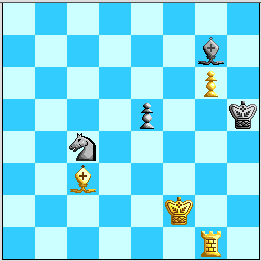 Position after 54. Rg1 in alternative main line.
A long road to a sunset, made shorter by new 6-piece EGTBs.
Position after 54. Rg1 in alternative main line.
A long road to a sunset, made shorter by new 6-piece EGTBs.
In contrast to analogous positions with Black's e-pawn on e6 that would
arise if White were to move in the main Zugzwang position at move 50,
here the weaknesses on e4 and f5 are fatal. The key difference is that
Black cannot trade the Knight for White's Bishop, as Black has no chance
of getting the King to f6 to cover the entry points. Positions with
Bxd4 exd4 are likewise hopeless for Black, and are marked +/- instantly.
However, Black would be able to delay White considerably were it not for
Ken Thompson's recent tabulation of six-piece pawnless endings. Certain
KRB vs. KBN positions with both pawns traded are known to reach a
previously-known win in 12--14 moves, but these wins may have been just
out of reach under the game conditions with all 5-piece engings plus
Eugene Nalimov's KQQ vs. KQQ. Even when Crafty is set to the position
after both pawns vanish, with the relevant 5-piece EGTBs installed and
48MB of RAM hash-table space on a 400Mhz processor (benching 140,000 nodes
per second), the win becomes known only after !!! hours of search.
This is not to mention the difficulty of realizing these positions win
when the search is rooted several moves back, say at move 55.
White's slower win, not allowing the trade of pawns, appears to have the
following main line: 54...Nd6 55. Bd2 Ne4+ 56. Ke2 Nd6 (56...Nf6
57. Rg2! is a Zugzwang that hurts sooner) 57. Rg5+ Kh4 58. Rg2 Kh5
59. Kf3 e4+ 60. Ke3! Nc4+ 61. Ke2 Nd6 62. Bf4 Ne8 63. Ke3 Nf6 64. Rg1!
with a final fatal Zugzwang. The quicker win goes this way, after 1) 54...Nd6
and alternate options 2) 54...Nb6, 3) 54...Kh6, and 4) 54...Kh4.
N21) 54...Nd6 55. Ke3(!) and now a big fanning out: 1) 55...Nf5+,
2) 55...Nc4+, 3) 55...Nb5, 4) 55...Ne8, 5) 55...Nc8, 6) 55...Kh6,
7) 55...Kh4, and 8) 55...Bh6+.
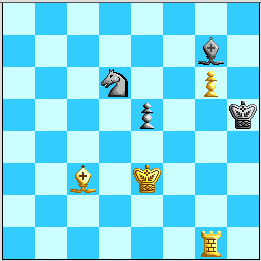 Position after 55. Kf2-e3! Much quicker than 55. Bd2.
Position after 55. Kf2-e3! Much quicker than 55. Bd2.
N211) 55...Nf5+ 56. Ke4, and now try 1) 56...Ne7, 2) 56...Nh4, and
3) 56...Nd6+:
N2111) 56...Ne7 57. Bd2 and now Black has a basic choice:
1) 57...Nxg6, 2) 57...Ng8, 3) 57...Bf6, 4) 57...Nc6, 5) 57...Nc8:
N21111) 57...Nxg6 and now:
N211111) 58. Rg5+ Kh6 59. Rxe5+ Kh7 60. Re6! EGTB+/-.

Ken Thompson's 6-piece tables show that White will
win a piece or trade down to a winning case of R vs. B
or R vs. N within 14 moves. To verify that White has no
other wins that might have been discovered here:
N211112) 58. Kf5 Nh4+ 59. Ke6 (else repeat) and now:
N2111121) 59...Nf3? 60. Rxg7 Nxd2 61. Kxe5 EGTB+/- #30.
N2111122) 59...Bh6! and now:
N21111221) 60. Bxh6 Kxh6 is EGTB= even without Black's e-pawn.
N21111222) 60. Bc3/b4 Bf4 and Black seems to have no worries.
N211113) 58. Bc1 (playing for Zugzwang) Bf8 (forced but OK), and:
N211131) 59. Rg5+ Kh6 60. Rxe5+ Kg7! EGTB=.
N211132) 59. Kf5 Nh4+ 60. Kf6 Bh6(!) and now:
N2111321) 61. Bxh6 Kxh6 is EGTB= even without Black's e-pawn.
N2111322) 61. Bb2/a3 Bf4 and Black seems to have no worries.
Instead, 58. Rg2 and 58. Be3 seem to be even less effective, as they
allow Black extra forking opportunities, e.g.
N211114) 58. Be3 and now:
N211141) 58...Bf8 and now:
N2111411) 59. Rg5+ Kh6 60. Rxe5+ Kg7! is still drawn.
N2111412) 59. Kf5 Nh4+ 60. Kxe5 ditto.
But Black also survives with:
N211142) 58...Bf6 59. Kf5 Ne7+ (forced) and now:
N2111421) 60. Kxf6 Nd5+ 61. Kxe5 Nxe3 EGTB=.
N2111422) 60. Ke6 Bh4 (again forced) 61. Kxe5 Ng6+! EGTB=.
Here other moves besides 61. Kxe5 seem to make no headway.
N21112) 57...Ng8 58. Kf5! Ne7+ 59. Ke6 and now:
N211121) 59...Nxg6 60. Rg5+ Kh6 61. Rxe5+ Kh7 62. Re3(!)
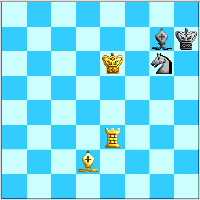
EGTB+/-, with material win or trading down to a
winning 4-piece ending within 8 moves. These twin
cases are the foundation of the quicker 55. Ke3 win.
N211122) 59...Ng8 60. Kf7+/-.
N21113) 57...Bf6 58. g7 Ng8 59. Kf5+/-. Thus Black cannot move
K or B here and is down to remaining N moves.
N21114) 57...Nc6 58. Kd5 and now:
N211141) 58...Ne7+ 59. Ke6 transposes into N21112).
N211142) 58...Nd4 59. Rg2! with:
N2111421) 59...Nf5 60. Ke6 Nh4 61. Rh2 Kg4 62. Kf7 Nf5
63. Rf2+/-.
N2111422) 59...Kh4 60. Bc3 and now:
N21114221) 60...Kh3 61. Bxd4! exd4 (61...Kxg2 62. Bxe5
EGTB+/- #16) 62. Rg1! Kh4 63. Rd1+/-.
N21114222) 60...Nf3 and now not
N211142221) 61. Rf2?! Kg3 62. Rxf3+? Kxf3 63. Bxe5 Kg4!
EGTB=, but
N211142221) 61. Ke4! Ng5+ 62. Kf5 Nf3 63. Rf2 Kg3
64. Rxf3+! Kxf3 65. Bxe5 EGTB+/- #18.
N2111423) 59...Nf3 60. Bc3 (or 60. Be3) Ng5 (else we
transpose to N21114222) 61. Bxe5 Bxe5 62. Kxe5 Kxg6
63. Kf4+/-.
N211143) 58...Nd8 59. Bc3+/-.
N211144) 58...Nb8 59. Ke6+/-.
N21115) 57...Nc8 58. Kf5 Nd6+ (else transpose into above lines)
59. Ke6 Nc4/e4 60. Kf7! Nxd2 61. Kxg7 Nf3 62. Kh7+/-.
N2112) 56...Nh4 and now White has several ways to hang Black's minors
out to dry:
N21121) 57. Be3 Nxg6 (forced!) 58. Rg5+ Kh6 59. Rxe5+ Kh7
60. Re6! EGTB+/-. This is the last occurrence of the
6-piece EGTB win. But White doesn't need it here.
N21122) 57. Rh1! Kg5 (57...Kg4 58. Bxe5! Bxe5 59. Rxh4+! +/-)
58. Ba5! Nxg6 (nothing else) 59. Bd8+ Kg4 60. Rg1+ Kh5
61. Kf5+/-.
N2113) 56...Nd6+ 57. Kd5 N-any 58. Ke6+/-.
N212) 55...Nc4+ 56. Ke4 and now:
N2121) 56...Kh6 57. Kd5 Nb6+ 58. Ke6+/-.
N2122) 56...Kh4 57. Kd5 Ne3+ 58. Ke6+/-.
N2123) 56...Nd6+ 57. Kd5+/- transposing to N2113).
N213) 55...Nb5 and now:
N2131) 56. Bxe5? Bxe5 57. g7 Bxg7 58. Rxg7 Kh6! EGTB=
N2132) 56. Bd2! and now:
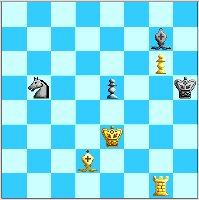
N21321) 56...Nd6 57. Kf3! is a key Zugzwang:
N213211) 57...Nc4 58. Bb4!+/- with 59. Ke4 coming.
N213212) 57...e4+ 58. Kf4 and now:
N2132121) 58...Bh6+ 59. Ke5 and now:
N21321211) 59...Bxd2 60. g7 and now:
N213212111) 60...Bc3+ 61. Kxd6 Bxg7 62. Rxg7+/-.
N213212112) 60...Nf7+ 61. Kf6 Nh6 62. Rh1+ +/-.
N21321212) 59...e3 60. Bb4+/-.
N2132122) 58...Nc4 59. Kf5!+/-.
N21322) 56...Nd4 57. Ke4 and now:
N213221) 57...Ne6 58. Be3! +/- with 59. Kf5 next.
N213222) 57...Ne2 58. Rg2 Nd4 59. Be3+/-, e.g. 59...Nb5
60. Kf5 Nd6+ 61. Ke6 Nc4 62. Bc1! and over.
N213223) 57...Nb5 58. Be3 Nd6+ 59. Kd5 Ne8 60. Ke6+/-.
N213224) 57...Nc6 58. Kd5 is N21114).
N213225) 57...Kh4 58. Be3+/- again with Kf5 soon.
N21323) 56...Bh6+ 57. Ke4! Bxd2/Nd6+ 58. g7/Kd5 Nd6+/Bxd2
59. Kd5/g7+/-.
N214) 55...Ne8 56. Ke4 Nf6+ 57. Kf5+/-.
N215) 55...Nc8 56. Ke4+/-, with transpose into above lines.
N216) 55...Kh6 56. Bb4 and now:
N2161) 56...Nf5+ 57. Ke4 and now:
N21611) 57...Nh4 58. Rh1+/-.
N21612) 57...Nd4 58. Bd2+ Kh5 59. Be3 and now:
N216121) 59...Nc2 60. Bc5+/- as Black's Knight is trapped.
N216122) 59...Ne2 60. Rg2 Nc3+ 61. Kf5+/-.
N216123) 59...Ne6 60. Kf5+/-.
N216124) 59...Kh4 60. Bxd4 exd4 61. Kf5 Kh3 62. Ke6+/-.
N2162) 56...Nc4+ 57. Ke4 Nb6/b2 58. Kf5+/-.
N2163) 56...Nb5 57. Ke4 Nd4 58. Bd2+ is N21612).
N2164) 56...Ne8/c8/b7 57. Kf5+/-.
N217) 55...Kh4 56. Bb4 and now:
N2171) 56...Nf5+ 57. Ke4 and now:
N21711) 57...Ng3 58. Be1+/-.
N21712) 57...Nd4 58. Bd2! and now:
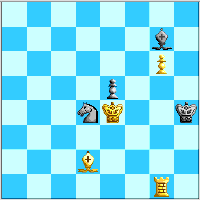
N217121) 58...Kh5 59. Be3+/-.
N217122) 58...Ne2 59. Rg2 Ng3+ 60. Kf3 e4+ 61. Kf4 Bh6+ (forced)
62. Ke5 Bg7+ 63. Ke6 Kh3 64. Rh1 and Black's cavorting
is soon put to an end.
N217123) 58...Ne6 59. Be3+/- with 60. Kf5 next.
N21713) 57...Nh6 58. Bd2+/-.
N2172) 56...Nc4+ 57. Ke4+/- as Black's Knight is contained.
N2173) 56...56...Ne8 57. Ke4 Nf6+ 58. Kf5+/-.
N2174) 56...Nc8 57. Ke4+/-, again with Black's Knight cut off.
N218) 55...Bh6+ 56. Kd3 and now:
N2181) 56...e4+ 57. Ke2 any 58. g7+/-.
N2182) 56...Bg7 57. Bb4 and now!:
N21821) 57...Nf5 58. Ke4 Nd4 (58...Nh4 59. Rh1+/-) 59. Rg2! Ne6
(else 60. Bc3+/-) 60. Bd2 Kh4 61. Be3 Kh3 (else 62. Kf5+/-)
62. Rg1! and 63. Kf5 comes next.
N21822) 57...e4+ 58. Ke3 Bh6+ (else the e-pawn is lost) 59. Ke2 Nf5
60. Bc3 Ne7 (60...Bg7 61. Bxg7 Nxg7 62. Ke3+/-) 61. g7 Ng8
62. Bd2! Bxd2 63. Kxd2 Kh6 64. Ke3 Kh7 65. Kxe4 EGTB+/- #12.
Black cannot draw "Lasker-Lasker"-type positions when the
Black King is cut off on the h-file.
This finishes Black's major defense 54...Nd6. The second defense
requires only a couple other fine points from White.
N22) 54...Nb6 55. Bd2 (55. Bxe5? Bxe5 56. g7 Bxg7 57. Rxg7 EGTB=.
doesn't work, but is worth remarking on), and now:
N221) 55...Nc4 56. Ke2 and now:
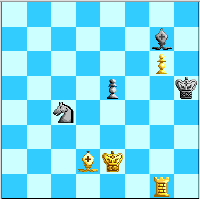
N2211) 56...e4 57. Bf4 with:
N22111) 57...Nb6 58. Rg5+ Kh4 59. Rb5 N-any 60. Rb7+/-.
N22112) 57...Kh4 58. Rg5 and the finishes are:
N221121) 58...Ne5 59. Rxe5+/-.
N221122) 58...Be5 59. Rxe5+/-.
N221123) 58...Nb6 59. Rb5+/-.
N2212) 56...Nxd2 57. Kxd2+/-.
N2213) 56...Nd6 57. Kf3 transposes into N21321).
N2214) 56...Nb6 57. Kd3 and now:
N22141) 57...Nd5 58. Ke4 Ne7 59. Be3! and we've seen this before:
N221411) 59...Nxg6 60. Rg5+ Kh6 61. Rxe5+ Kh7 62. Re6 EGTB+/-.
N221412) 59...Kh4 60. Rh2+ Kg4 61. Rh7+/-.
N221413) 59...N-other 60. Kf5+/-.
N22142) 57...Nd7 58. Ke4 Nf8 59. Kf5+/-.
N22143) 57...Nc8 58. Ke4 Nd6+ 59. Kd5+/-.
N2215) 56...Kh4 57. Rh2+ Kg4 58. Rh7+/-.
N2216) 56...Nb2 57. Kf3! Nc4 58. Bb4+/-, as in N216) or N218).
N2217) 56...Na5/a3 57. Kd3+/-.
N222) 55...Nd5 56. Kf3 and now:
N2221) 56...Nf6 57. Rg2! is another key Zugzwang:
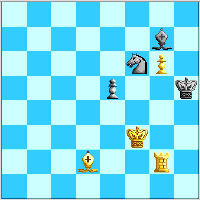
N22211) 57...Kh4 58. Rh2#.
N22212) 57...e4+ 58. Kf4 e3/Bh6+ 59. Kf5+/-.
N22213) 57...Ne8 58. Ke4 Nd6+ 59. Kd5+/-.
N2222) 56...Ne7 57. Ke4 transposes into N2211).
N2224) 56...Nb6/c7 57. Ke4+/-.
N223) 55...Nd7 56. Kf3 and now:
N2231) 56...Nf6 57. Rg2 is N2221).
N2232) 56...Nc5 57. Rg2! and now:
N22321) 57...e4+ 58. Kf4 Bh6+ 59. Kf5+/-.
N22322) 57...Ne6 58. Ke4 Nd4 (else 59. Kf5) 59. Be3+/-.
N22323) 57...Kh4 58. Rh2#.
N22324) 57...Nd7 58. Ke4 Nf6+ 59. Kf5+/-.
N224) 55...Nc8 56. Ke4 Nd6+ 57. Kd5+/-.
This finishes 54...Nb6. We conclude by checking that Black fares
no better by wiggling with his King.
N23) 54...Kh6 55. Ke2 and now Black can only delay Kd3:
N231) 55...Bf6 56. Bb4! White threatens 57. Bf8+ winning a piece,
and 56...Bg7 57. Kd3 has been seen, so 56...Kg7 57. Ke4 and now:
N2311) 57...Kh6 58. Bf8+ Bg7 59. Rh1+ +/-.
N2312) 57...Bh4/d8 58. Kf5 Ne3+ 59. Kxe5+/-.
N2313) 57...Nb6 58. Kf5 Nd5 59. Bd6 Ne3+ 60. Ke6 Nc4 61. Bf8+ +/-.
N232) 55...Bh8 56. Kd3 Nb6/d6 57. Rh1+ +/-.
N233) 55...N-any 56. Bd2+ Kh5 transposes into above lines.
N234) 55...Kh5 56. Kd3 and now:
N2341) 56...Nd6 57. Ke3 transposes into the N21) stem position,
while 57. Bb4! is quicker.
N2342) 56...Nb6 57. Ke4+/-, based on previous analysis.
N24) 54...Kh4 55. Ke2 and now:
N241) 55...Kh5 56. Kd3 transposes into N234).
N242) 55...Nd6 56. Bb4 and now:
N2421) 56...Ne4 57. Ke3!+/-, domination!
N2422) 56...Nf5 57. Kd3 Nd4 (anything else transposes to above lines)
58. Bd2! and now:
N24221) 58...Nf3 59. Rh1+ Kg4 60. Rh7 e4+ 61. Ke3! Bd4+ 62. Kxe4+/-.
N24222) 58...Kh5 59. Ke4 and now:
N242221) 59...Ne6 60. Be3+/-.
N242222) 59...Ne2 60. Rg2 Nd4 61. Be3+/-.
N24223) 58...Ne6 59. Ke4 and now:
N242231) 59...Nd4 60. Be3+/-.
N242232) 59...Kh5 60. Be3+/-.
This finishes position N) and the entire 48. Rb1! analysis!
 Position L), after 48. Rf1-b1. Starting point for White's ending win.
Position L), after 48. Rf1-b1. Starting point for White's ending win.Position L), after 48. Rf1-b1. Starting point for White's ending win.
Position M), after 50. Rh1 in main line. Zugzwang! (mutual!)
Position after 50...Ke4. 51. Rd1 Kf5! would only repeat, but...
Position after 53. Bc3!! White's main sacrificial strike.
Position after 54...Na3 in main "waiting" line. Are White's pawns corraled?
Position after 54...Na3 in alternate "waiting" line. Play it again Sam?
Position after 52. Kf2! in main line. Black is so close but too late.
Position after 54...Kxg7 in first main line. A publishable study.
Position after 55...Kh6 in main line. Which King move wins?.
Position after 62. Rb7 in main-line/transpositions. Black's ultimate end.
Position after 56...e3. Again, which King move wins?
Position after 54. Rg1 in alternative main line. A long road to a sunset, made shorter by new 6-piece EGTBs.
Position after 55. Kf2-e3! Much quicker than 55. Bd2.